It seemed appropriate to give the “softer side” of our trip to China, observations I noticed, such as the flowers, which were every-where possible and all trimmed and lovingly cared for. One example was a wall of flowers in an elaborate pattern composed of plants in individual pots and somehow set into it; apparently this is a standard planting technique for flower beds as well, at least the ones we saw. There were few overweight Chinese as the majority walk or bicycle everywhere. They need to be agile, as cars, trucks, buses, motorcycles, scooters, motorized bicycles with a rickshaw setup for passengers, all competing nonstop for spaces in traffic, and pedestrians do not have priority. As Chris told us, “Look four ways twice” before trying to cross a street! The other part of the street scene is vendors trying to sell passersby everything imaginable, “very cheap” and they are eager to haggle, in fact almost insist on it. These folks are also present at every tourist attraction; the walk up to the Great Wall was lined with them. Meals, ordered by our translator with input from us, were placed, dish after dish, on a huge lazy-susan in the middle of the table. They included lots of tofu, spicy or not, always bok choy, cabbage or swiss chard, a fish and/or meat dish, then rice, and last, soup (it is impolite to fill your soup bowl to the top) and fruit – usually watermelon. Then came the challenge to master chop sticks in order to get the food to one’s plate, not to mention in your mouth – there were spoons for the soup! Speaking of food, we went to a “wet market” where vegetables and fruits were displayed. The meat section was piles of meat – pork, chicken, beef – to be picked over by buyers – a big pyramid of hamburg that was picked up by hand and placed in a plastic bag to be weighed. It was a little shocking as we are used to everything being packaged and in a cooler, but we learned that food is purchased every day, taken home and eaten right away. I stayed away from where the live chickens were, with customers waiting. There were fish, eel, shrimp, clams, crab, etc., swimming around in tanks. Back on the sidewalk there were, besides “very cheap” sellers, street cleaners, mostly women, using what looked like a witches broom made of twigs to sweep up any bit of debris – a lot of cigarette butts, despite “No Naked Flames” signs. There were bicycles passing by with huge loads of cardboard folded for recycling and laundry was hung from racks attached to apartment house balconies. We visited temples which were crowded with people burning in-cense, bowing and praying to Buddha as well as patting the heads of big reddish fish which is believed to bring good fortune, and leaving money in and on the various statues of gods. There are many rituals and traditions the Chinese observe. One last thing to mention were the ladies rooms away from hotels – the “facility” is a porcelain basin set into the floor, no hand holds, and paper goes into a wastebasket. Enough about that! The Chinese people seemed genuinely anxious to try to talk with us Americans, which was gratifying, and their work ethic is to be admired. For someone who originally said no way she would go to China, it was an extraordinary trip, largely thanks to Chris Barbieri’s great organizing, choice of guides, introducing us to new Chinese foods, sights, and all with a fun group of VAE members.
Year: 2012
Throwing Down a Challenge
With the new year quickly approaching, I want to throw down a challenge to all members and spouses to introduce a younger person to something of value from your past. Possibly, an old movie, the 1st car you drove, a long forgotten dance or anything that is not currently deemed popular by the masses. A number of years ago, I was standing at a counter waiting for a young lady to take my sandwich order. The news was on; reporting on the life and passing of Elizabeth Taylor. I commented that this was truly a loss. The young lady proceeded to tell me that she had never seen Taylor in her youth or seen her in a movie. I told her that she was only one of the most iconic women in the motion picture industry. How can you go through life without seeing National Velvet or Lassie Come Home filmed in 1943. I have an eleven year old daughter who I continually expose to the best classic Americana has to offer. In our home Fred Astaire & Ginger Rogers, classic cars, chrome bumpers, big bands, black & white movies and the waltz are not a thing of the past but an every day staple.
“Alternative” Preventative Maintenance – Dave’s Garage
I recently embarked on the task of winterizing my vehicles. I realized that my Subaru still has the original alternator, and it has 195,000 miles on it. I have never had an alternator last this long. When I brought the car in for an inspection, I asked the guy how often they replaced alternators on Subarus. He said they replace a few. I asked him how many miles do they last. He told me they can go at anywhere between 80,000 and 150-160,000. Hum. I called Auto Electric in Williston and asked them how long this particular alternator lasts. They said they seem to last between 100,000 and 150,000 miles. I asked what wears out, and they said the basic wear items- brushes and bearings, but the rest of the alternator holds up well. I asked what it would cost to recondition a working alternator and was quoted between $50 and $80.
I priced remanufactured alternators and saw prices starting in the range of $150.00 and quickly going up well past $200.00 (not including the core charge).
I removed the alternator and decided to bring it in. The first thing I noticed is that when I spun the pulley, the bearings sounded rough. Auto Electric replaced the bearings, brushes and the regulator. The brushes were almost completely gone, and the bearings made noise. Final cost was $80, or less than half what it would have cost to buy a re-manufactured alternator. This remedy also avoided a potential road side break down and unplanned down time.
Penetrating fluid update:
Recently I recommended a mixture of acetone and ATF as an alternate penetrating oil, and I stated that I would try it and report back with my findings. I have done a lot of work recently, work involving removing very rusted nuts and bolts, pressing out frozen bearings, freeing heavily rusted frozen parking brakes, and removing brake bleeder nipples and hydraulic fittings.
I am happy to report that this home brewed concoction has worked very well, exceeding my expectations. The only down side is that the ATF and acetone do not like to remain in suspension, so I have to shake my oil can before each use. The fluid needs to be kept in a sealed container, as acetone evaporates quickly.
I hope you try it, and have as much success as I have had.
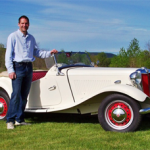 Please email all inquiries to: Dave
Please email all inquiries to: Dave
or snail mail
32 Turkey Hill Road
Richmond VT 05477
My 1963 Austin Mini
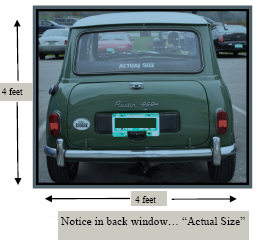 Following WWII, the British auto industry was under the mandate of “Export or Die”. As a result, the most popular imported cars in the States after the War were British. According to Ward’s Auto World, the British had a 96% share of the U.S. imported car market in 1952. Today it is less than 1%. Popular post-war British cars were the MG TD and the Jaguar XK120. When most “car people” think of British cars, sports cars come to mind. Indeed, at the British Invasion of Stowe car show, Austin Healeys, MGs and Triumphs are the most popular entries among the hundreds of cars that show up.
Following WWII, the British auto industry was under the mandate of “Export or Die”. As a result, the most popular imported cars in the States after the War were British. According to Ward’s Auto World, the British had a 96% share of the U.S. imported car market in 1952. Today it is less than 1%. Popular post-war British cars were the MG TD and the Jaguar XK120. When most “car people” think of British cars, sports cars come to mind. Indeed, at the British Invasion of Stowe car show, Austin Healeys, MGs and Triumphs are the most popular entries among the hundreds of cars that show up.
But the highest volume product ever made by the British auto industry was the Mini. With 5,387,862 units produced from 1959 to 2000, the Mini outlasted several of its corporate owners. Though Minis were never imported in great numbers to the U.S., they were highly innovative when introduced and set the style of transverse engine design for practically all front-wheel drive cars that followed. The concept was exceptional:
a practical sub-compact car 10 feet long, 4 feet wide, 4 feet tall that would seat 4 adults. Over 80% of the car’s volume is for its occupants. Its 10″ wheels are located at the corners of the body. Originally called the Austin Seven, the car came equipped with a 38 h.p. 4 cylinder en-gine of 850cc. capacity. By 1964, some were factory-modified with a 1275 cc, 78 h.p. engine by Formula I car designer John Cooper. Thus was born the Austin Cooper, aka Austin Mini Cooper. These cars went on to win rugged European rallys with boring regularity in the 1960s, including the Monte Carlo Rally in 3 separate years. A highly modified Mini from New Zealand recently clocked over 200 mph at Bonneville.
Most Mini enthusiasts don’t recognize the current BMW-made Mini offering as a “proper” Mini: It weighs almost twice as much and is a full 2 feet longer. It is available in styles that are even heavier and longer yet. That being said, the new Mini is a car better suited for American conditions than the original Mini ever was. In standard form, the old Minis suffered from the usual British car maladies: overheating, leaking oil, weak engine internals, poorly shifting transmissions and generally poor quality control. But an old Mini is so light and small that it can corner at frightening speeds if you keep your right foot into it. It has been described as a go-cart on steroids, with (as the Brits would say) cheeky good looks to boot.
I bought my Austin Mini around 1977, but family responsibilities kept me from getting it on the road until the late 1990s. I had wanted one since I was a kid in the 1960s. Knowing the mechanical shortcomings of the original car, I knew I was fated to perform an engine swap. The Japanese small car field could provide the powerplant needed to make my Mini a durable highway performer. Equipped with a tape measure, I checked the junkyards for a donor vehicle with an engine/transmission of suitable size, such that I wouldn’t have to cut the Mini body. I found such a front-wheel drive power unit in a 1993 Geo Metro. I was a bit wary at first since this car has a computer on board to control the fuel injection system. But then I reasoned that it’s only wiring and I should not fear. I was right – with a factory wiring schematic I could tell where each wire had to go and it all worked out well.
This Geo Metro engine is made by Suzuki and it is “the Little Engine that Could”. It is a 3 cylinder, 993 cc. 55 h.p. unit coupled to a 5 speed transmission that shifts as smooth as silk and weighs 100 pounds less than the original 38 h.p. engine. My car weighs in at just under 1300 pounds without the driver. The powerplant swap necessitated some tricky surgery on the front subframe but it, too, went well. My Mini looks absolutely stock. But its a sleeper that will elicit a loud chirp from the front wheels when you shift into 2nd gear with a little extra throttle. Its a blast to drive. A recent 210 mile trip was accomplished using 4.1 gallons of regular gas. Prius owners, eat your hearts out!
Rubber Fuel Lines and Ethanol – Dave’s Garage
I have heard of people having problems with collapsed fuel lines due to attack by ethanol. Although most of my fuel line is metal, there has to be a short section of flexible line between the body and the carburetor. Is there any specific material you know of that is impervious to ethanol? When I asked that question at my local parts store, he first gave me a blank stare, then asked what kind of car it was for. When I told him it was for a ’29 Plymouth, I got another blank stare. Then he said he didn’t know of anything and suggested I use non-ethanol gas. That’s pretty consistent with your last column. -Wendell Noble
First, the good news:
Fuel line today is made of neoprene, not rubber. It is impervious to the alcohol in E10 ethanol. I usually use fuel injection hose, not fuel line because it is much more substantial. This is available in auto parts stores in 1/4″, 5/16″ and 3/8″. If you really want to be sure, you can use marine fuel line. This stuff will holdup to E85 and bio diesel. Marine fuel hose can be purchased from marine supply stores.
I would remove a section of the flexible hose and bring it to the auto parts store. The old rubber fuel hose will dissolve with the E10 ethanol we are stuck with today. Replacing the old rubber hose with new neoprene is cheap, easy and makes the car much safer and more reliable.
 Please email all inquiries to: Dave
Please email all inquiries to: Dave
or snail mail
32 Turkey Hill Road
Richmond VT 05477
Have Buick Will Travel
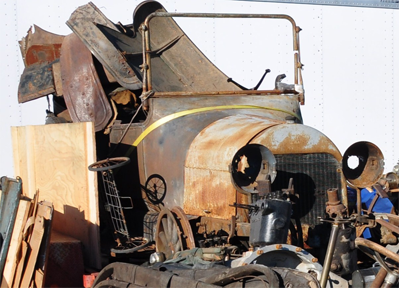 Vin Cassidy, the tale is told, purchased this 1915 Buick Tourer in Iowa last year (2011) but did not have the room to haul it back to his home-base in Rowley, Massachusetts. Vin and his family operate Cassidy Brothers Forge in Rowley where some very beautiful architectural wrought iron is manufactured. Along with running the sales department, Vin also buys and sells vintage auto parts throughout the U.S. If you are ever in his neighbor-hood you really need to stop by and tour the many garages and containers of old car parts in the rear of the forge business. Many VAE members have bought some of Vin’s treasures at surprisingly low prices.
Vin Cassidy, the tale is told, purchased this 1915 Buick Tourer in Iowa last year (2011) but did not have the room to haul it back to his home-base in Rowley, Massachusetts. Vin and his family operate Cassidy Brothers Forge in Rowley where some very beautiful architectural wrought iron is manufactured. Along with running the sales department, Vin also buys and sells vintage auto parts throughout the U.S. If you are ever in his neighbor-hood you really need to stop by and tour the many garages and containers of old car parts in the rear of the forge business. Many VAE members have bought some of Vin’s treasures at surprisingly low prices.
Now back to the tale and travels of Vin’s Buick…. Earlier this year Vin returned to Iowa and hauled his Buick home. Then in August, deep inside of our Stowe Car Show vendor area we could all hear an engine cough a couple of times then take off with a bang or two. It was Vin’s 1915 Buick looking about what it looks like in the picture to the left. Someone could be seen stand on the trailer feeding fuel to the engine and working the carbure-tor….Vins Buick had arrived in Stowe! No one at the show was interested in buying the car so Vin hauled it back home. During the return trip one of the doors fell off requiring Vin to back-track to Stowe looking for it. This reporter forgot to ask Vin if he found it so you can ask when you see him next.
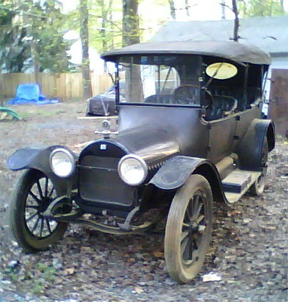 Fast-forward to the Fall Hershey Car Show…. And guess what is making it’s appearance? ….The 1915 Buick sitting rather lost on it’s trailer! About the second day of the show some ‘higher old-car power’ kicked in and yup you guessed it…a person from Iowa appeared and was interested in buying the Buick. It is told the Buick is now residing in Forest City, Iowa with a possible bright future.
Fast-forward to the Fall Hershey Car Show…. And guess what is making it’s appearance? ….The 1915 Buick sitting rather lost on it’s trailer! About the second day of the show some ‘higher old-car power’ kicked in and yup you guessed it…a person from Iowa appeared and was interested in buying the Buick. It is told the Buick is now residing in Forest City, Iowa with a possible bright future.
Buick made around 42,000 cars in 1915, 19,080 of them were touring cars like Vin’s and the car pictured to the right. They were also still making carriages in 1915, in fact a completed carriage would come out of their factory every ten minutes, some 25,000 each year. The company started around 1850 as McLaughlin Carriage Company not far from Oshawa, Ontario and made it’s first automobile in 1907. In the beginning the cars were known as “McLaughlins”. Later the name changed to “Mclaughlin-Buick” then became simply “Buick” when the company became General Motors of Canada in 1915. Interestingly, until 1914 the cars were finished with the same paints and varnishes the company used on their carriages…some fifteen coats on every car.
Shelburne Area Tour


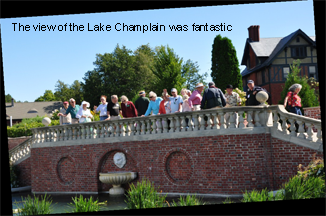 There was an international bicycle race in Burlington on the 18th of August with many roads closed to cars. That only meant the VAE had to get up earlier for our tour start at Wake Robin at 8:30AM. After a grand welcome and breakfast treats from the Wake Robin folks the tour started with many Wake Robin residents joining us. The tour included Shelburne Farms and a wonderful loop into Charlotte where we even found the ‘shortest covered bridge in the world’. The pictures will tell the rest of the story.
There was an international bicycle race in Burlington on the 18th of August with many roads closed to cars. That only meant the VAE had to get up earlier for our tour start at Wake Robin at 8:30AM. After a grand welcome and breakfast treats from the Wake Robin folks the tour started with many Wake Robin residents joining us. The tour included Shelburne Farms and a wonderful loop into Charlotte where we even found the ‘shortest covered bridge in the world’. The pictures will tell the rest of the story.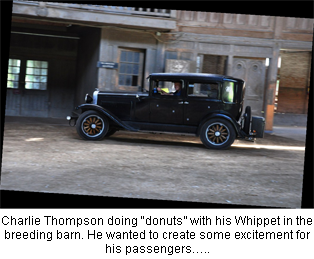
Penetrating Fluid 101 – Dave’s Garage
I have passed along the tip of using a 50/50 mixture of ATF and Acetone as an alternative to penetrating oil. Anybody who has turned a wrench on a daily driver, or restored their pride and joy knows what happens to all the hardware on our vehicles here in the wet, snowy salty northeast. There is a reason the northeast is referred to as the rust belt.
I have used both PB Blaster and Liquid Wrench for years. Of the two, I had a preference for PB Blaster.
I have mixed up the ATF/Acetone mixture for small jobs, but found it to be time consuming and hard to brush the mixture on to frozen hardware as needed. I recently bought an inexpensive oil can and filled it with the ATF/Acetone mixture. This will be my dedicated penetrating fluid can. I will use this as my first plan of attack when I am confronted by frozen hardware, and report back with the results. I’m already quite pleased with the savings. This concoction is a lot more economical than com-mercially available penetrating oils. Word of caution: Acetone is a solvent, and will mar paint and plastics.
Not convinced? Here’s the cold, hard facts from the April/May 2007 edition of Machinist’s Workshop. They did a test of penetrating oils where they measured the force required to loosen rusty test devices. The results reported were interesting. (The lower the number of pounds the better).
Penetrating oil Average load Price per fluid ounce
- None …………………516 pounds
- WD-40 ………………238 pounds ……$0.25
- PB Blaster …………214 pounds .. $0.35
- Liquid Wrench ……127 pounds ……$0.21
- Kano Kroil …………106 pounds ……$0.75
- ATF-Acetone mix…53 pounds ……. $0.10
-
 Please email all inquiries to: Dave
Please email all inquiries to: Dave
or snail mail
32 Turkey Hill Road
Richmond VT 05477
The 40s (Part II)
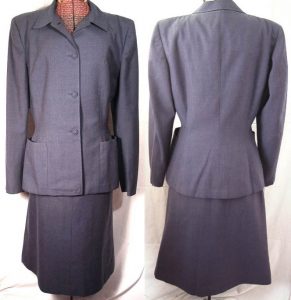 American designers came to the forefront in the fashion world with the closing of the Parisian fashion houses, boosting such designers as Clare Potter, Claire McCardell and Carolyn Schnurer in sportswear.
American designers came to the forefront in the fashion world with the closing of the Parisian fashion houses, boosting such designers as Clare Potter, Claire McCardell and Carolyn Schnurer in sportswear.
Lilli Ann suits were made in San Francisco and Hattie Carnegie designed fine dresses in New York City.
Very fashionable dresses were designed with sweetheart necklines, side zippers and drapery that flowed from side to side. Casual wear consisted of pleated pants, print cotton dresses in patriotic motifs, polka dots, checks and abstract designs in bold colors.
Suits and dresses were worn with platform-soled shoes. Cork wedge was used in place of leather and steel during the war. Suede and fabric platform sandals and mules were fashionable and in Italy, bakelite was used for soles and heels.
The outrageous hats of the previous decade were replaced with turbans, crowned hats, hand knitted caps, and calots worn at the back of the head. Kerchiefs and veils tied under the chin were a chic trend, with hats becoming frivolous again after the war with veiled turbans adorned with fruits and flowers. Hairstyles were rolled or pageboys.
In 1947 Christian Dior’s “New Look” was a totally different design with unpadded soft round shoulders, padded hips and full skirts with pleating at the waist, calf-length skirts with crinolines in rich feminine fabrics. Hats were very small and designed to coordinate with specific dresses.
Men’s clothing also had fabric and design restrictions. No cuffs, pleats or overlapping waistbands. Vests were limited, and the two-piece suit replaced the traditional 3 pieces. Backless vests were used for eveningwear, with narrower trousers and shorter jackets made with rayon, rayon blends and flannel. Battle jackets were popular casual wear.
The “Zoot” suit made a brief appearance, but was considered a waste of too much fabric. It was styled with oversized coats, big shoulders, slash pockets, full knees, cuffs, trousers hiked up with suspenders and oversized bow ties. Does this look similar to what the boys are wearing today?
The Hawaiian shirts picked up by servicemen as souvenirs became casual wear in the late forties. (Original shirts are very expensive and highly collectable today.) The bold post war look contrasted with the somberness of the war years with broad shoulders, wide lapels, wide spread collars, large cufflinks, plaid socks, and colorful ties.
Ties were the mainstay of the forties with patriotic colors during the war. Hand painted designs and photo ties in vivid colors inspired by art deco. After the war luxurious silk ties were manufactured once again.
(Missed Part I? Read it here…)
From the “Cookie” at the Stowe Show – Savory Chicken Pot Pie recipe
Ingredients
- 1 Tablespoon olive oil
- 1-16 oz. Can chicken broth
- 1 Medium onion, diced
- 1 Tablespoon fresh chopped parsley
- 2 Large chicken breasts, cut into cubes
- Salt and pepper to taste
- 1 Large russet potato, peeled and cubed
- 1 tablespoon butter
- 2 Large carrots peeled and cubed
- 2 tablespoons of flour
- ½ Cup frozen peas
- 2 Pie crusts for 10 inch pie (ready made or homemade)
Directions
In large skillet, heat the olive oil till almost smoking then add the onions and sauté them stirring them to coat with olive oil. Then add cubed chicken, cook until onions are translucent and chicken is cooked through, stirring often. Remove to a bowl. Heat the chicken broth to a boil then add the potatoes and carrots to cook them through, simmering about 15 mins. Reserving the broth strain the potatoes and carrots and add them to the chicken. Add the peas as well. In the same sauté pan heat 1 tablespoon butter and add 2 tablespoons flour. Stir continuously over medium heat . Cook until it’s paste like…about 2 mins. Whisk the reserved chicken broth to it and cook until it thickens. Stir in all the vegetables, chicken and parsley. Add salt and pepper as needed. Place crust in bottom of deep-dish 10 inch pie pan. Pour the chicken and veggies over the bottom crust then place top crust on top. Crimp the edges. Cut 3 or 4 small slits in the top, place on cookie sheet and bake at 425 degrees for 40 mins or until the pie is hot and bubbly. The crust should be golden brown. Serves 4.










